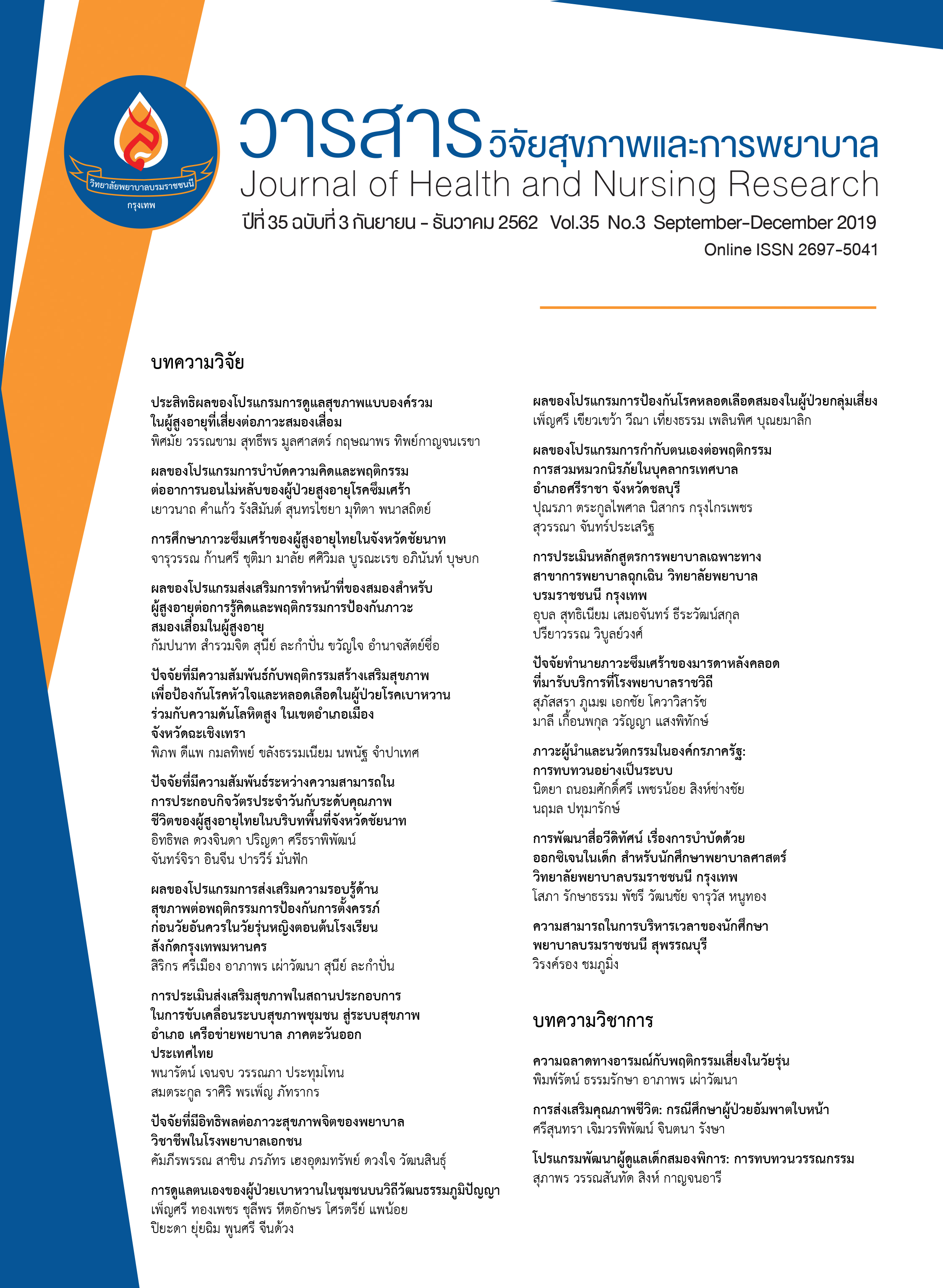ปัจจัยที่มีความสัมพันธ์กับพฤติกรรมสร้างเสริมสุขภาพเพื่อป้องกันโรคหัวใจและหลอดเลือดในผู้ป่วยโรคเบาหวานร่วมกับความดันโลหิตสูง ในเขตอำเภอเมือง จังหวัดฉะเชิงเทรา
คำสำคัญ:
พฤติกรรมสร้างเสริมสุขภาพ, โรคหัวใจและหลอดเลือด, ผู้ป่วยโรคเบาหวานร่วมกับความดันโลหิตสูง, การรับรู้ประโยชน์, การรับรู้ความสามารถตนเอง, การรับรู้อุปสรรคบทคัดย่อ
การวิจัยครั้งนี้เป็นการศึกษาเชิงพรรณนา เพื่อศึกษาปัจจัยที่มีความสัมพันธ์กับพฤติกรรมสร้างเสริมสุขภาพเพื่อป้องกันโรคหัวใจและหลอดเลือดในผู้ป่วยโรคเบาหวานร่วมกับความดันโลหิตสูง กลุ่มตัวอย่างเป็นผู้ป่วยโรคเบาหวานร่วมกับโรคความดันโลหิตสูง ที่มารับบริการในโรงพยาบาลส่งเสริมสุขภาพตำบล อำเภอเมือง จังหวัดฉะเชิงเทรา จำนวน 95 ราย เก็บข้อมูลด้วยแบบสอบถาม ประกอบด้วย 3 ส่วน ได้แก่ ส่วนที่ 1 แบบบันทึกข้อมูลส่วนบุคคลและข้อมูลสุขภาพ ส่วนที่ 2 แบบสอบถามพฤติกรรมสร้างเสริมสุขภาพเพื่อป้องกันโรคหัวใจและหลอดเลือดของผู้ป่วยที่เป็นโรคเบาหวานร่วมกับความดันโลหิตสูง มีค่าสัมประสิทธิ์แอลฟาเท่ากับ 0.79 ส่วนที่ 3 แบบสอบถามปัจจัยที่มีความสัมพันธ์กับพฤติกรรมสร้างเสริมสุขภาพเพื่อป้องกันโรคหัวใจและหลอดเลือดในผู้ป่วยโรคเบาหวานร่วมกับความดันโลหิตสูง มีค่าสัมประสิทธิ์แอลฟาเท่ากับ 0.70 วิเคราะห์ข้อมูลด้วยสถิติพรรณนา และทดสอบสมมติฐานด้วยการวิเคราะห์ความแปรปรวนทางเดียว และวิเคราะห์ค่าสัมประสิทธิ์สหสัมพันธ์
ผลการวิจัยพบว่า กลุ่มตัวอย่างมีพฤติกรรมสร้างเสริมสุขภาพเพื่อป้องกันโรคหัวใจและหลอดเลือดโดยรวมในระดับดี (Mean=3.21, SD=0.38) กลุ่มตัวอย่างที่มีระดับความเสี่ยงต่อการเกิดโรคหัวใจและหลอดเลือดแตกต่างกันมีค่าเฉลี่ยพฤติกรรมสร้างเสริมสุขภาพเพื่อป้องกันโรคหัวใจและหลอดเลือดต่างกันอย่างไม่มีนัยสำคัญทางสถิติ (F=0.575, p=.633) ปัจจัยการรับรู้ประโยชน์และการรับรู้ความสามารถของตนเองต่อการมีพฤติกรรมสร้างเสริมสุขภาพเพื่อป้องกันโรคหัวใจและหลอดเลือดมีความสัมพันธ์ทางบวกกับพฤติกรรมสร้างเสริมสุขภาพเพื่อป้องกันโรคหัวใจและหลอดเลือดอย่างมีนัยสำคัญทางสถิติ (r=.402, p<.001 และ r=.617, p<.001 ตามลำดับ) ขณะที่ปัจจัยการรับรู้อุปสรรคต่อการมีพฤติกรรมสร้างเสริมสุขภาพเพื่อป้องกันโรคหัวใจและหลอดเลือดมีความสัมพันธ์ทางลบกับพฤติกรรมสร้างเสริมสุขภาพเพื่อป้องกันโรคหัวใจและหลอดเลือดอย่างมีนัยสำคัญทางสถิติ (r= -.530, p<.001)
จากผลการวิจัยครั้งนี้ สามารถนำไปเป็นข้อมูลพื้นฐานเพื่อการพัฒนาโปรแกรมหรือกิจกรรมสร้างเสริมพฤติกรรมเพื่อป้องกันโรคหัวใจและหลอดเลือดสำหรับผู้ป่วยโรคเบาหวานร่วมกับความดันโลหิตสูง โดยเน้นให้มีการรับรู้ประโยชน์และความสามารถของตนเอง ร่วมกับการลดการรับรู้อุปสรรคต่อการมีพฤติกรรมสร้างเสริมสุขภาพเพื่อป้องกันโรคหัวใจและหลอดเลือด
Downloads
เอกสารอ้างอิง
2. WHO. Noncommunicable diseases country profiles 2018. 1st ed. Geneva: World Health Organization;2018.
3. Liangchawengwong S. Lifestyle-Related Cardiovascular Risk FactorsAmong Thai University Studentswere Crisis?. Journal of Science and Technology. 2013;21(7):668-76. (in Thai).
4. Shah A, Afzal M. Prevalence of diabetes and hypertension and association with various risk factors among different Muslim populations of Manipur, India. Journal of Diabetes & Metabolic Disorders 2013;12(52):1-10.
5. Ekphalakorn W. The survey of the Thai public health by the 5th physical examination 2014. 1st ed.Bangkok: Graphic and Design Publishing House; 2014. (in Thai).
6. Petrie JR, Guzik TJ, Touyz RM. Diabetes, Hypertension, and Cardiovascular Disease: Clinical Insightsand Vascular Mechanisms. Can J Cardiol 2018;34(5):575–84.
7. Walker SN, Sechrist KR, Pender NJ. Health Promotion Model - Instruments to Measure Health Promoting Lifestyle : Health-Promoting Lifestyle Profile [HPLP II] (Adult Version) [Internet]. 1995.[cited 2018 Oct 4]. Available from http://hdl.handle.net/2027.42/85349
8. AHA. Understand Your Risks to Prevent a Heart Attack [Internet]. 2016. [cited 2018 Sep 10]. Available from https://www.heart.org/en/health-topics/heart-attack/understand-your-risks-to-preventa-heart-attack#.WxUQ60iFOM8
9. Ghazali SM, Seman Z, Cheong KC, Hock LK, Manickam M, Kuay LK, et al. Sociodemographic factors associated with multiple cardiovascular risk factors among Malaysian adults. BMC Public Health 2015;15(68):7-8.
10. Sinsap N, Jankra J, Jaiman B. Hypertension in Elderly: Silence Killer Should be Aware. Journal of Phrapokklao Nursing College 2017;26(1):100-11. (in Thai).
11. Pender N.J, Murdaugh CL, Parsons MA. Health Promotion in Nursing Practice. 7th. USA: Pearson Education Inc; 2015.
12. Suthisant S, Chongphaiboonphatana W. Factors influencing health promoting behaviors amongprofessional nurses in nursing service division, government university hospitals[Internet]. 2009.[cited 2018 Sep 14]. Available from http://kb.psu.ac.th/psukb/handle/2010/8656
13. Phumankian S. The relationship between perceived benefit of action, perceived self-efficacy, and health promotion behaviors of elderly with coronary artery disease in heart clinic of kalasin hospital, kalasin province [master's degree]. [Chonburi]: Burapha University; 2013. (in Thai).
14. Thimoonnee M, Preechawong S. Factors Related to Preventive Behaviors For Cardiovascular Disease in Premenopausal Cleaning Personnel. Kuakarun Journal of Nursing 2016;23(1):118-32. (in Thai).
15. Thanakwang K, Kespichayawattana J, Jitpanya C. Factors related to health promotion behaviors among older persons: a meta-analysis. Journal of Nursing Science 2010;28(3): 60-68. (in Thai).
16. Muang Chachoengsao District Health Service Network. Health Strategy Plan for the fiscal year 2017-2021 (Mueang Chachoengsao Health System) Health Network District, Chachoengsao District, Fiscal Year 2018. Chachoengsao; Health Network Chachoengsao District: 2018. (in Thai).
17. Bureau of Non-Communicable Diseases Department of Disease Control. Assessment of risk factors for cardiovascular disease in patients with diabetes and hypertension. 1st ed. Bangkok: The Agricultural Cooperative Assembly of Thailand Printing Company Limited; 2015. (in Thai).
18. Sathokkit P. Tools to assess the risk of heart disease and stroke. [Internet]. 2016. [cited 2018 Sep 12]. Available from http://www.thaincd.com/document/file/download/powerpoint/3.Evolution Tools A.Priny CVD.pdf
19. Sirikangwankun W, Thato R, Polsook R. Factors Predicting Preventive Behaviors for Coronary Artery Disease among the Royal Thai Army Personnel. Journal of Nursing Science Chulalongkorn University 2017;29(2):99-111. (in Thai).
20. Sutthipatthanangkoon C, Thato R. Factors predicting preventive behaviors for coronary artery disease among autonomous university staff in Bangkok. Thai Journal of Cardio-Thoracic Nursing 2017;28(2):111-25. (in Thai).
21. Bureau of Non-Communicable Diseases Department of Disease Control. Survey of risk factors for non-communicable diseases and injuries. 1st ed. Nonthaburi: Department of Disease Control, Ministry of Public Health; 2010. (in Thai).
22. Ashwell M, Gunn P, Gibson S. Waist-to-height ratio is a better screening tool than waist circumference and BMI for adult cardiometabolic risk factors: Systematic review and meta-analysis. Obesity Reviews 2012;13(3):275-86.
23. Health Education Division, Department of Health Service Support. Health behavior surveillance system to change the risk behavior of norma /risk groups /diabetes, hypertension in Thailand: policies to practice for primary health care facilities.1st ed. Bangkok: Department of Health Service Support Ministry of Public Health; 2013. (in Thai).
24. Eriksen A, Tillin T, O’Connor L, Brage S, Hughes A, Mayet J, et al. The Impact of Health Behaviors on Incident Cardiovascular Disease in Europeans and South Asians – A Prospective Analysis in the UK SABRE Study. PLoS ONE 2015;10(3):1-15.
25. Chumpathat N, Kangchai W, Rattanajarana S. Factors Related to Preventive Behaviors Regarding Coronary Artery Disease among Elderly with Metabolic Syndrome. HCU Journal of Health Science 2018;22(43-44):114-29. (in Thai).
26. Carpenter CJ. A meta-analysis of effectiveness of health belief model variables in predicting behavior. Health Communication 2010;25(8):661-69.
27. Joychoo N, Pinyopasakul W, Chareonkitkarn V. Relationships among age, perceived benefits of health behaviors, perceived barriers of health behaviors and health behaviors in patients with ischemic stroke. Ramathibodi Nurs J 2014;20(2):236-48. (in Thai).
28. Jianvitayakit S, Panpakdee O, Malathum P, Duff. Factors Influencing Smoking Cessation Behavior among Thai Male Smokers with Hypertension. Pacific Rim International Journal of nursing Research 2014;18(2):100-10.
29. Lo SW, Chair SY, Lee FK. Factors associated with health-promoting behavior of people with or at high risk of metabolic syndrome: Based on the health belief model. Applied Nursing Research 2015;28(2):197-201.
30. Horwood H, Williams MJ, Mandic S. Examining motivations and barriers for attending maintenance community-based cardiac rehabilitation using the health-belief model. Heart, Lung and Circulation 2015;24(10):980-87.
31. Yue Z, Li C, Weilin Q, Bin W. Application of the health belief model to improve the understanding of antihypertensive medication adherence among Chinese patients. Patient Education and Counseling 2015;98(5):669-73.
ดาวน์โหลด
เผยแพร่แล้ว
รูปแบบการอ้างอิง
ฉบับ
ประเภทบทความ
สัญญาอนุญาต
บทความที่ได้รับการตีพิมพ์ เป็นลิขสิทธิ์ของวารสารวิจัยสุขภาพและการพยาบาล (วิทยาลัยพยาบาลบรมราชชนนี กรุงเทพ) ไม่สามารถนำไปตีพิมพ์ซ้ำในวารสารฉบับอื่น


















